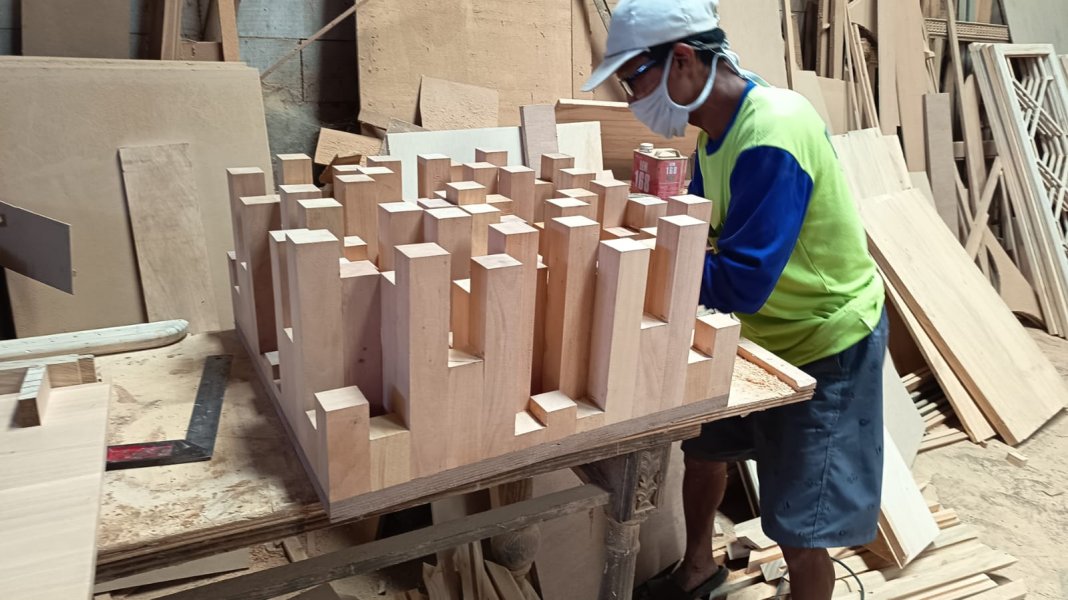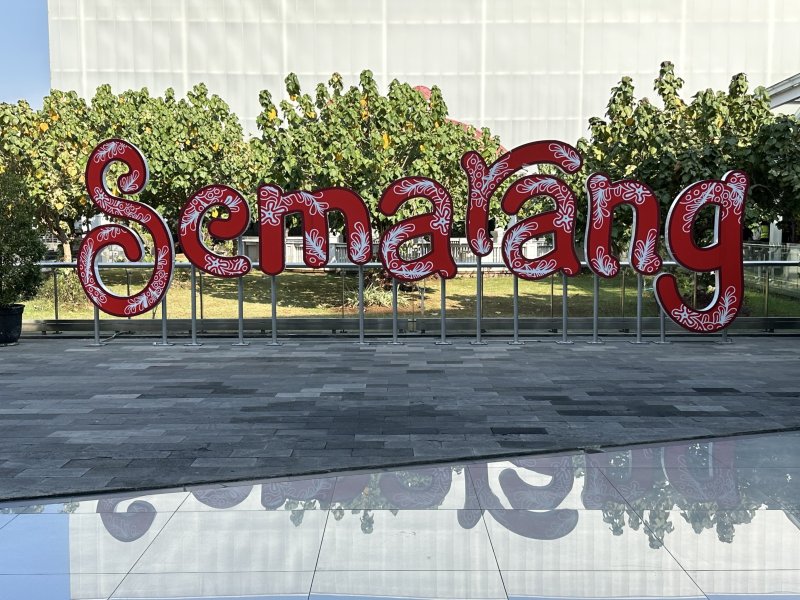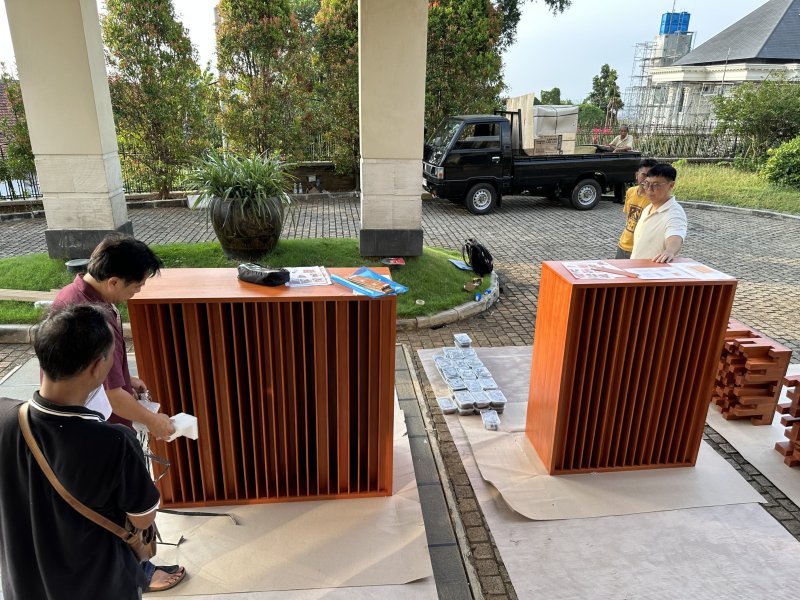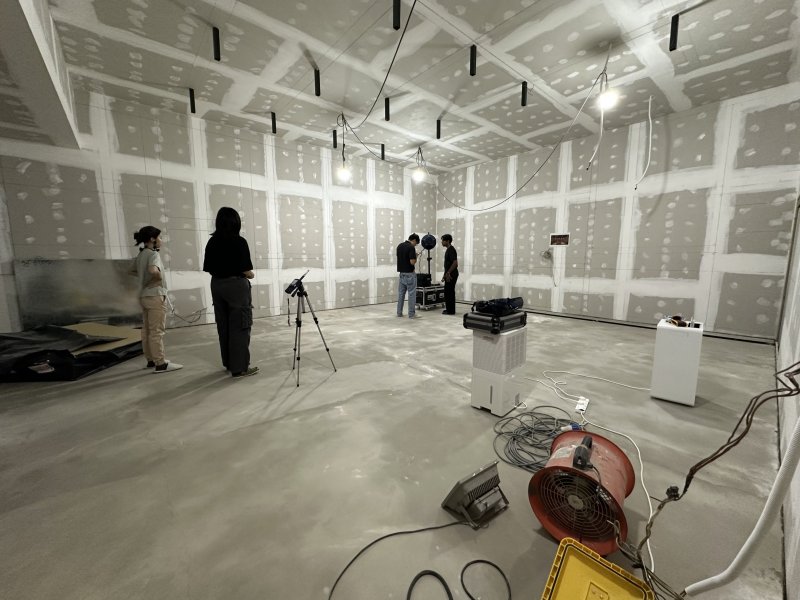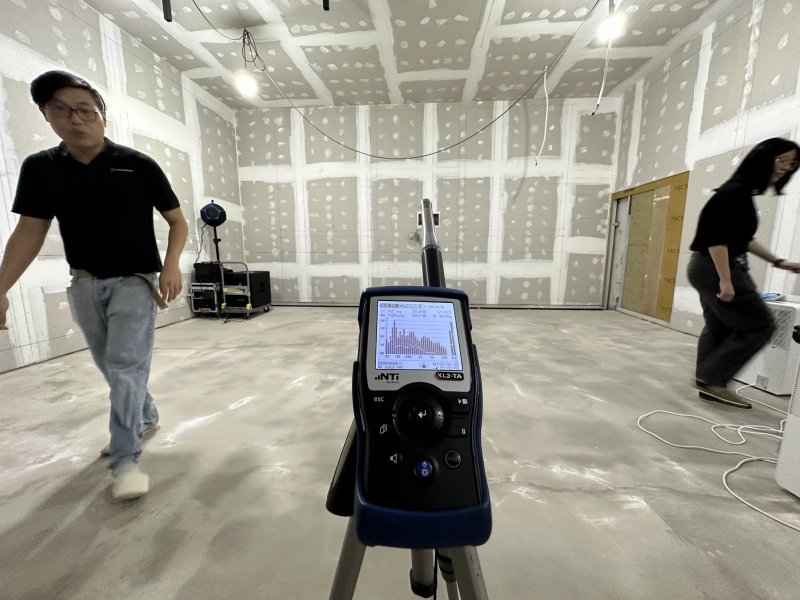My dedicated audio room build - QuadDiffusor's Big Dig
- Thread starter QuadDiffuser
- Start date
You are using an out of date browser. It may not display this or other websites correctly.
You should upgrade or use an alternative browser.
You should upgrade or use an alternative browser.
Rear wall:
4 pcs. 3.0mm thick, 1.2m x 1.8m
2 pcs. 3.0mm thick, 1.0m x 1.5m
Rear Right corner:
1 pc. 1.5mm thick, 1.2m x 1.5m (mounted diagonally)
1 pc. 1.5mm thick, 1.2m x 1.0m (mounted diagonally)
Rear Left corner:
1 pc. 1.5mm thick, 1.2m x 1.5m (mounted diagonally)
1 pc. 1.5mm thick, 1.2m x 1.0m (mounted diagonally)

4 pcs. 3.0mm thick, 1.2m x 1.8m
2 pcs. 3.0mm thick, 1.0m x 1.5m
Rear Right corner:
1 pc. 1.5mm thick, 1.2m x 1.5m (mounted diagonally)
1 pc. 1.5mm thick, 1.2m x 1.0m (mounted diagonally)
Rear Left corner:
1 pc. 1.5mm thick, 1.2m x 1.5m (mounted diagonally)
1 pc. 1.5mm thick, 1.2m x 1.0m (mounted diagonally)

Last edited:
Last edited:
Wow .. are you doing these in non correlating patternsThis prototype P13 Skyline 2D diffuser constructed from plywood backboard and 169 SOLID mahogany blocks weighs 39kg.
49 pcs. will equal 1,911kgs, or nearly two (2) metric TONS!
View attachment 157343
Hi Phil,
I'm not sure what you mean by "non-correlating patterns".
These block heights (and patterns) were generated using prime number sequences of N=13 from the freely downloadable program "QRdude". Repeating patterns are definitely visible, and hence not as random as one might expect.
However, there is definitely a mathematical logic to this pattern which I suspect is the output of an optimization model designed to achieve maximum variability across multiple dimensions, not just strictly the horizontal 1D or the vertical 1D axis.
I will most likely be using 49 pieces of the identically-built Skyline diffusors for my ceiling installation, mostly because the Indonesian builder will most likely produce the most consistent product that way.
Are you suggesting that I introduce some randomness in the pattern of the blocks? This can be done by using the push/pull "shifting" function on the software, but I'm worried that the manufacturing complexity will be too challenging. What are some of the most tangible benefits to doing this? Please share your experience. Thank you!
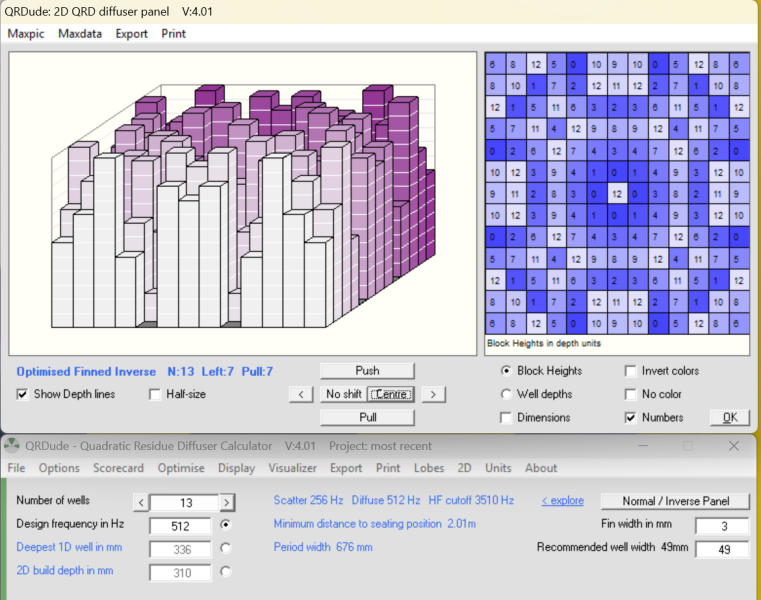
I'm not sure what you mean by "non-correlating patterns".
These block heights (and patterns) were generated using prime number sequences of N=13 from the freely downloadable program "QRdude". Repeating patterns are definitely visible, and hence not as random as one might expect.
However, there is definitely a mathematical logic to this pattern which I suspect is the output of an optimization model designed to achieve maximum variability across multiple dimensions, not just strictly the horizontal 1D or the vertical 1D axis.
I will most likely be using 49 pieces of the identically-built Skyline diffusors for my ceiling installation, mostly because the Indonesian builder will most likely produce the most consistent product that way.
Are you suggesting that I introduce some randomness in the pattern of the blocks? This can be done by using the push/pull "shifting" function on the software, but I'm worried that the manufacturing complexity will be too challenging. What are some of the most tangible benefits to doing this? Please share your experience. Thank you!

Last edited:
What I was referring to was the pattern of location each diffuser panel to avoid (as much as possible ) a repeat of the same interaction of reflections at each boundary creating a reinforcement of that result .. like a macro view of the entire ceiling plane as single diffuser that evens out the overall pattern. You could orient each panel differently in clusters of 4 and then spin those clusters in a larger pattern.Hi pjwd,
I'm not sure what you mean by "non-correlating patterns".
These block heights (and patterns) were generated using prime number sequences of N=13 from the freely downloadable program "QRdude". Repeating patterns are definitely visible, and hence not as random as one might expect.
However, there is definitely a mathematical logic to this pattern which I suspect is the output of an optimization model designed to achieve maximum variability across multiple dimensions, not just strictly the horizontal 1D or the vertical 1D axis.
I will most likely be using 49 pieces of the identically-built Skyline diffusors for my ceiling installation, mostly because the Indonesian builder will most likely produce the most consistent product that way.
Are you suggesting that I introduce some randomness in the pattern of the blocks? This can be done by using the push/pull "shifting" function on the software, but I'm worried that the manufacturing complexity will be too challenging. What are some of the most tangible benefits to doing this? Please share your experience. Thank you!
View attachment 157352
Because this is listening space with a very defined point source and the angle of incidence on the diffuser will vary anyway this may not be an issue .. I mentioned it as I have worked with an acoustic engineer who optimized the reverbarent field in a conference room with non corellated patterns of diffusion and it worked well ... but that was a different function
Cheers
Phil
Hi Phil, yes I understand your question better now. For this particular P13 Skyline 2D diffuser design (see the diagram generated by QRdude), there's mirror-symmetry in both 1D dimensions (left/right (lateral), and front/back) so diversification in placement is not possible.
As mentioned before, there is a possibility of using the "shift" function to stagger the geometry of the blocks to deliberately introduce diversity. However, the extra labor and hyper-scrutiny required during manufacturing may be too challenging to scale production efficiently, leading to higher costs. Symmetry is actually a visual attribute, as the eye/brain expects to see it to a great extent, suggesting balance and low defects.
I believe that there's sufficient round-trip distance between the speaker (source) and perimeter QRDs (floor and walls) to completely dilute whatever positive correlation might emanate from the ceiling 2D Skylines. The lower scattering frequency of 256Hz and the lower diffusion frequency of 512Hz, implies that the relevant wavelengths [based on the speed of sound at 24*C of 1,135 ft/sec] are 4.44ft and 2.22ft, respectively.
In fact, there is an item on the QRdude design (in blue text) which says, "Minimum distance to seating position" of 2.01m. The shortest path from my listening position to the ceiling (directly overhead) exceeds that.
As mentioned before, there is a possibility of using the "shift" function to stagger the geometry of the blocks to deliberately introduce diversity. However, the extra labor and hyper-scrutiny required during manufacturing may be too challenging to scale production efficiently, leading to higher costs. Symmetry is actually a visual attribute, as the eye/brain expects to see it to a great extent, suggesting balance and low defects.
I believe that there's sufficient round-trip distance between the speaker (source) and perimeter QRDs (floor and walls) to completely dilute whatever positive correlation might emanate from the ceiling 2D Skylines. The lower scattering frequency of 256Hz and the lower diffusion frequency of 512Hz, implies that the relevant wavelengths [based on the speed of sound at 24*C of 1,135 ft/sec] are 4.44ft and 2.22ft, respectively.
In fact, there is an item on the QRdude design (in blue text) which says, "Minimum distance to seating position" of 2.01m. The shortest path from my listening position to the ceiling (directly overhead) exceeds that.
Last edited:
Ah yes I did not notice the symmetry ...I agree on keeping it simple for the contractor's .. they would blow a fuse if you had multiple variations !Hi Phil, yes I understand your question better now. For this particular P13 Skyline 2D diffuser design (see the diagram generated by QRdude), there's mirror-symmetry in both 1D dimensions (left/right (lateral), and front/back) so diversification in placement is not possible.
As mentioned before, there is a possibility of using the "shift" function to stagger the geometry of the blocks to deliberately introduce diversity. However, the extra labor and hyper-scrutiny required during manufacturing may be too challenging to scale production efficiently, leading to higher costs. Symmetry is actually a visual attribute, as the eye/brain expects to see it to a great extent, suggesting balance and low defects.
I believe that there's sufficient round-trip distance between the speaker (source) and perimeter QRDs (floor and walls) to completely dilute whatever positive correlation might emanate from the ceiling 2D Skylines. The lower scattering frequency of 256Hz and the lower diffusion frequency of 512Hz, implies that the relevant wavelengths [based on the speed of sound at 24*C of 1,135 ft/sec] are 4.44ft and 2.22ft, respectively.
In fact, there is an item on the QRdude design (in blue text) which says, "Minimum distance to seating position" of 2.01m. The shortest path from my listening position to the ceiling (directly overhead) exceeds that.
I am out of my depth but here goes:
I have always assumed these diffusers are only calculated for a perpendicular incidence of sound source .. and the depth of the well gives you the lowets effective fr, however, as a first reflection point it will be at an angle you will get considerable scattering and a reduction in volume of the few reflections to the listening position so it will probably be fine ... but the defining dimension maybe the width of the rods .. a much higher fr.. or perhaps there is a cumulative effect .. it will look like a leaky Skyline diffuser to the sound.
I am sure they will work well.. especially to calm down the room and they will look spectacular
Cheers
Phil
Last edited:
P23 QRDs
Eight of these units will be combined onto the front wall of my basement listening room, covering a width of 5.18m (17.0ft) and a height of 2.66m (8.73ft) - see the green sections of the diagram below. Next, the photo at the very bottom of the page will give you an idea of what a 4 x 2 array of P-23 QRDs may look like, except that mine will be 33% wider than the front wall seen behind the Wilson Alexandria X-2 loudspeakers. (Based on its heights of 182cm, extrapolation suggests that they're placed 3.9m apart).
Each unit will weigh 160kg (350 lbs.) and are constructed from solid mahogany blocks, and the highest density of plywood for structural strength and uniformity, surface-laminated with select grades of mahogany.
With a deep diffusive bandwidth of 185Hz - 3,500Hz, they will be the workhorse of my system, smoothly dispersing my Von Schweikert Ultra.nine's rear ambience array's direct output (as well as other indirect acoustic energy from the rest of the room boundaries and speakers) into the front and sides of the room.

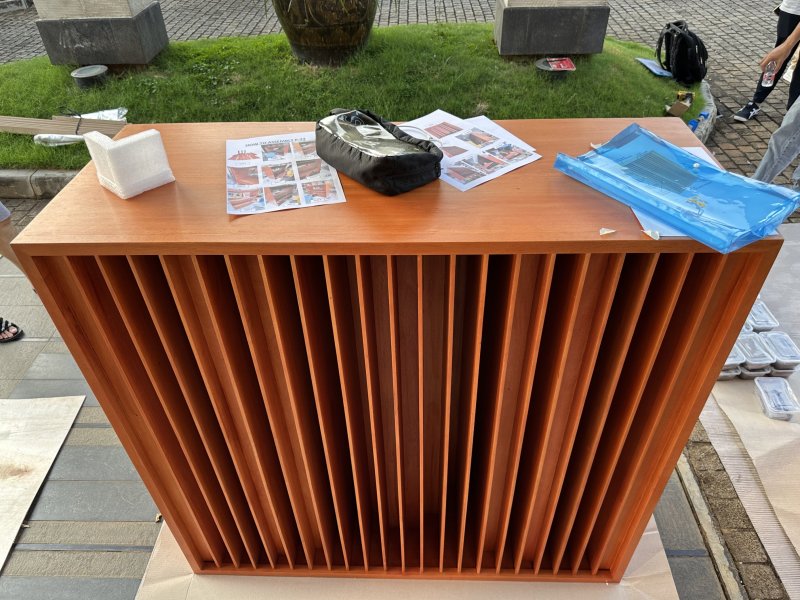
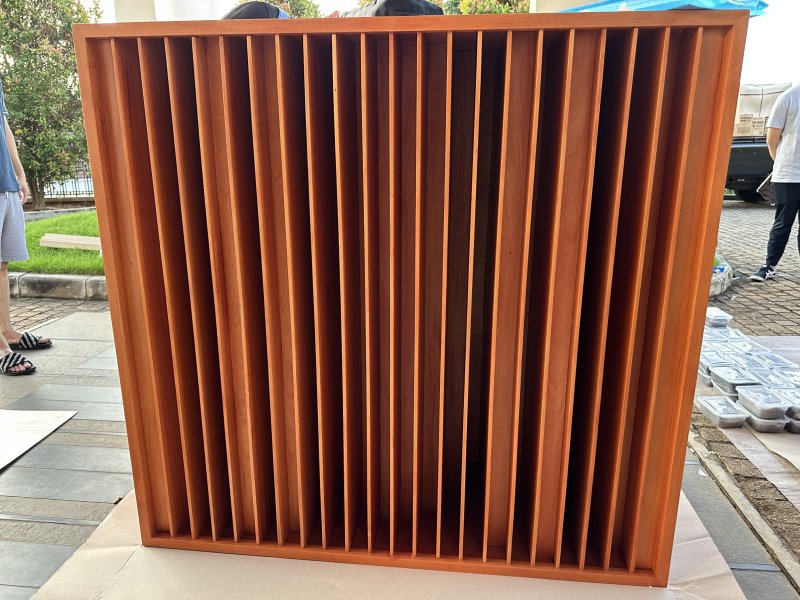
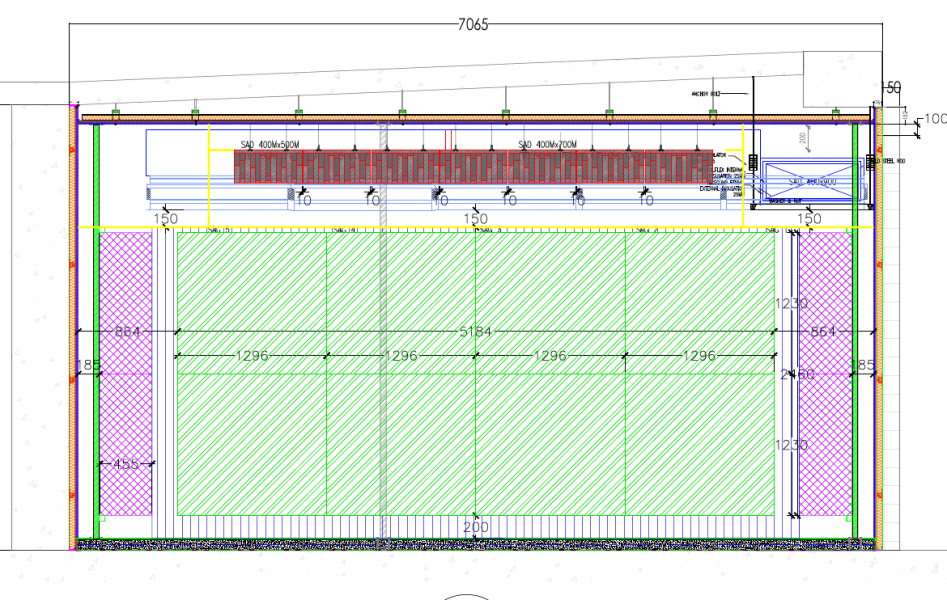
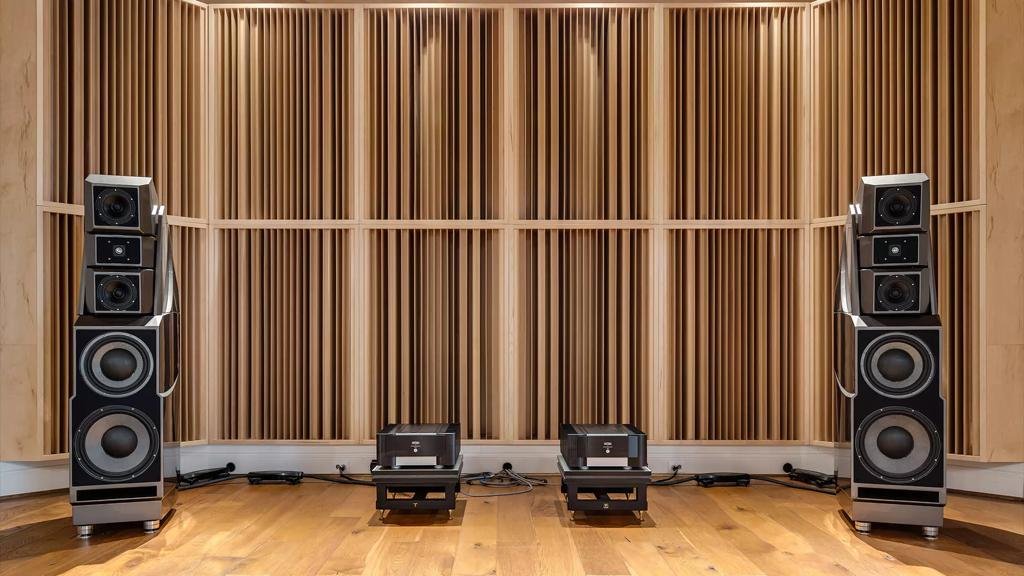
Eight of these units will be combined onto the front wall of my basement listening room, covering a width of 5.18m (17.0ft) and a height of 2.66m (8.73ft) - see the green sections of the diagram below. Next, the photo at the very bottom of the page will give you an idea of what a 4 x 2 array of P-23 QRDs may look like, except that mine will be 33% wider than the front wall seen behind the Wilson Alexandria X-2 loudspeakers. (Based on its heights of 182cm, extrapolation suggests that they're placed 3.9m apart).
Each unit will weigh 160kg (350 lbs.) and are constructed from solid mahogany blocks, and the highest density of plywood for structural strength and uniformity, surface-laminated with select grades of mahogany.
With a deep diffusive bandwidth of 185Hz - 3,500Hz, they will be the workhorse of my system, smoothly dispersing my Von Schweikert Ultra.nine's rear ambience array's direct output (as well as other indirect acoustic energy from the rest of the room boundaries and speakers) into the front and sides of the room.





Last edited:
...will your local guys assemble, or are you shipping them as finished products? That's a heavy load, either way, but fully assembled will be huge. Not that the entire project itself isn't huge...and "hugely" interesting. I recently saw a friend's back wall mostly-covered in QRDs and I love it. Please keep the photos coming... and thanks a lot for sharing, QD.
They will be shipped fully assembled, requiring more volume than a 20-foot equivalent container.
The 40-foot equivalent container will be HUGE!

The 40-foot equivalent container will be HUGE!
P17 QRDs
Ten of these units will be mounted on both left and right sidewalls of my basement listening room, covering a width of 4.65m (15.26ft) and a height of 2.66m (8.73ft) - see the purple sections of the diagrams below.
Each unit will weigh 114kg (251 lbs.), with the same construction components as the larger P23s described prior.
Its diffusive bandwidth of 225Hz - 3,500Hz will smoothly disperse my Von Schweikert Ultra.nine's sidewall signals (as well as other indirect acoustic energy from the rest of the room) into the front hemisphere.
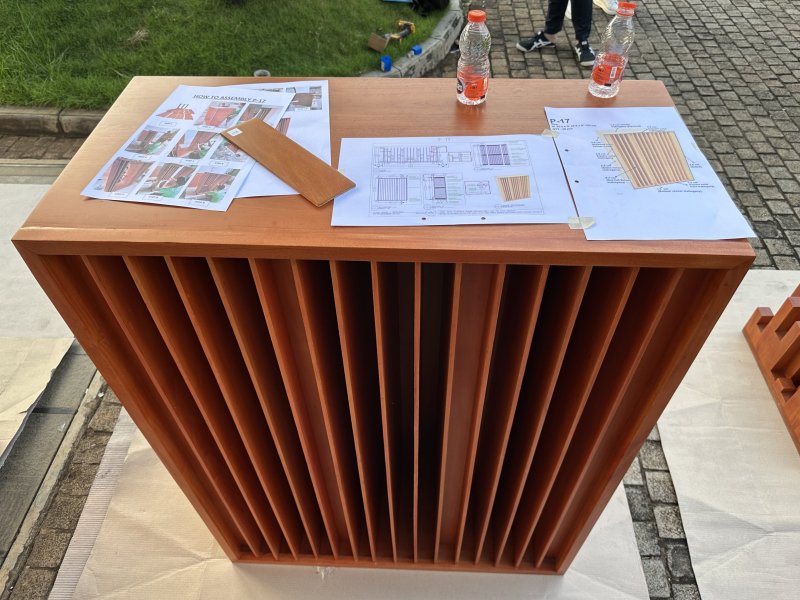
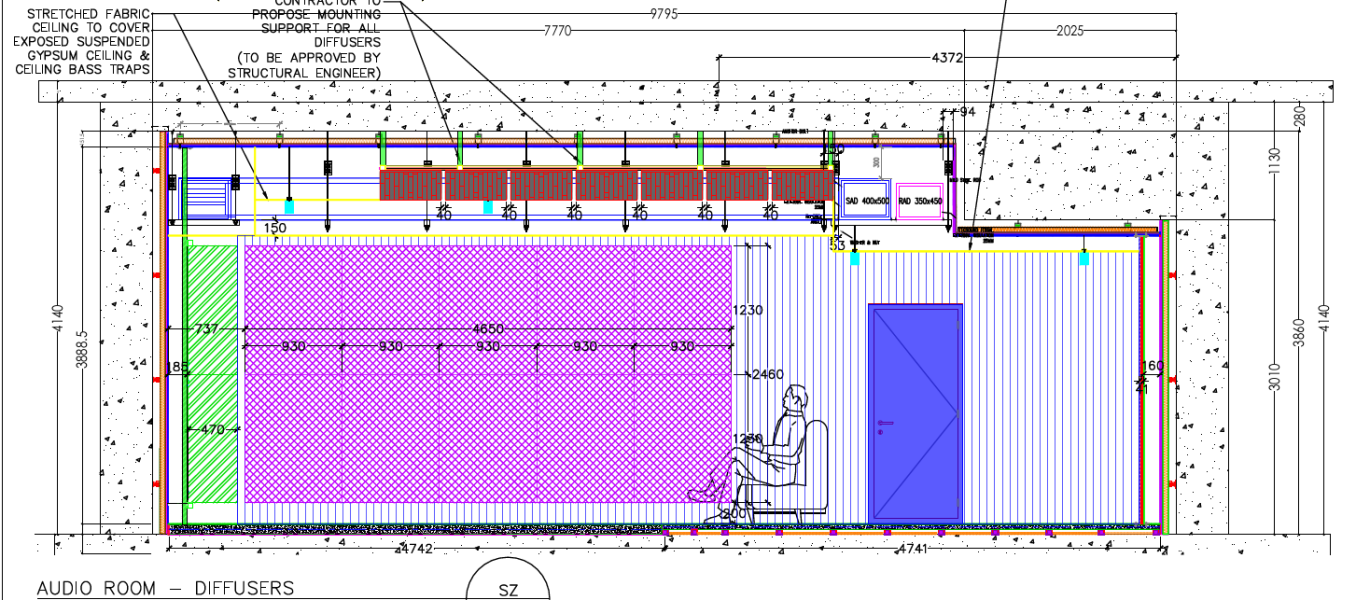
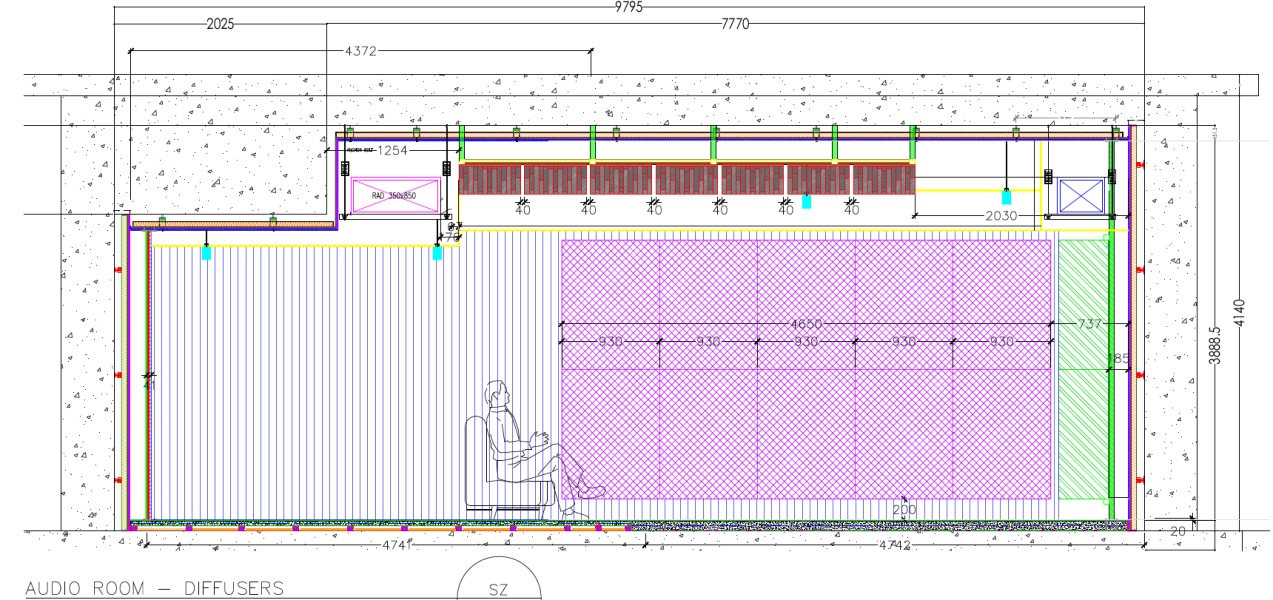
Ten of these units will be mounted on both left and right sidewalls of my basement listening room, covering a width of 4.65m (15.26ft) and a height of 2.66m (8.73ft) - see the purple sections of the diagrams below.
Each unit will weigh 114kg (251 lbs.), with the same construction components as the larger P23s described prior.
Its diffusive bandwidth of 225Hz - 3,500Hz will smoothly disperse my Von Schweikert Ultra.nine's sidewall signals (as well as other indirect acoustic energy from the rest of the room) into the front hemisphere.



Last edited:
So I think think this has been discussed here, but I'm not sure I saw any conclusion: on the side walls, given that much of the direct waves will not be hitting the QRDs at 90 degrees, would dispersion be better served by hemisphere diffusers? I've been wrestling with this issue for my room. Have you found any conclusive research? Thanks for sharing your journey.P17 QRDs
Ten of these units will be mounted on both left and right sidewalls of my basement listening room, covering a width of 4.65m (15.26ft) and a height of 2.66m (8.73ft) - see the purple sections of the diagrams below.
Each unit will weigh 114kg (251 lbs.), with the same construction components as the larger P23s described prior.
Its diffusive bandwidth of 225Hz - 3,500Hz will smoothly disperse my Von Schweikert Ultra.nine's sidewall signals (as well as other indirect acoustic energy from the rest of the room) into the front hemisphere.
View attachment 157819
View attachment 157820
View attachment 157821
Hi Music Master,
You'll find my conclusions within 10 posts of the following:
 www.whatsbestforum.com
www.whatsbestforum.com
Essentially, what's required is sufficient distance between the listening position and the sidewall QRDs, which narrower rooms won't have. Luckily in my very wide room, the reflections off the sidewall diffusers will be sufficiently delayed, diffused, and uncorrelated in phase so that neither discrete sonic localization nor phase shift anomalies will be discernable.
Specifically, the calculated time delay between the speaker's direct sound and the diffused sidewall reflection will be 7.1ms; according to research by O’Toole suggests that diffused sidewall reflections presented to the listening position at an angle of ~120 degrees (60* x 2) will be perceived as being wonderfully alive, natural, and spacious.
You'll find my conclusions within 10 posts of the following:
My dedicated audio room build - QuadDiffusor's Big Dig
Further simplifying, with recommendations expressed in a chart. Accordingly, instead of running my Ground conductor straight through in parallel as I have planned, instead I'll try to spiral it loosely around the tightly twisted Live + Neutral pair. Final Recommendation: The best...
Essentially, what's required is sufficient distance between the listening position and the sidewall QRDs, which narrower rooms won't have. Luckily in my very wide room, the reflections off the sidewall diffusers will be sufficiently delayed, diffused, and uncorrelated in phase so that neither discrete sonic localization nor phase shift anomalies will be discernable.
Specifically, the calculated time delay between the speaker's direct sound and the diffused sidewall reflection will be 7.1ms; according to research by O’Toole suggests that diffused sidewall reflections presented to the listening position at an angle of ~120 degrees (60* x 2) will be perceived as being wonderfully alive, natural, and spacious.
Last edited:
Thanks very much. Very helpfulHi Music Master,
You'll find my conclusions within 10 posts of the following:
My dedicated audio room build - QuadDiffusor's Big Dig
Further simplifying, with recommendations expressed in a chart. Accordingly, instead of running my Ground conductor straight through in parallel as I have planned, instead I'll try to spiral it loosely around the tightly twisted Live + Neutral pair. Final Recommendation: The best...www.whatsbestforum.com
Essentially, what's required is sufficient distance between the listening position and the sidewall QRDs, which narrower rooms won't have. Luckily in my very wide room, the reflections off the sidewall diffusers will be sufficiently delayed, diffused, and uncorrelated in phase so that neither discrete sonic localization nor phase shift anomalies will be discernable.
Specifically, the calculated time delay between the speaker's direct sound and the diffused sidewall reflection will be 7.1ms, and the reflected off-axis angle of ~120 degrees will be perceived as wonderfully alive, natural, and spacious.
P17 Skyline 2D QRDs
Weighing in at 39kgs each, these Skyline 2D QRDs are constructed from solid mahogany blocks, mounted on 25mm plywood.
49 pieces (or nearly 2,000kg!) of these will be mounted on the ceiling of my basement listening room at a height of 3.5m (11.5ft) , covering a width of 4.16m (13.6ft.) and a front/back length of 4.22m (13.8ft).
With its maximum depth/height of 265mm (10.4"), this 2D diffuser will start scattering sound from 300Hz, and from 600Hz up to 4.1kHz, diffuse musical energy into an amorphous but energetic overhead "cloud", creating the acoustic illusion of a much higher ceiling of perhaps ~5.0m (16ft).
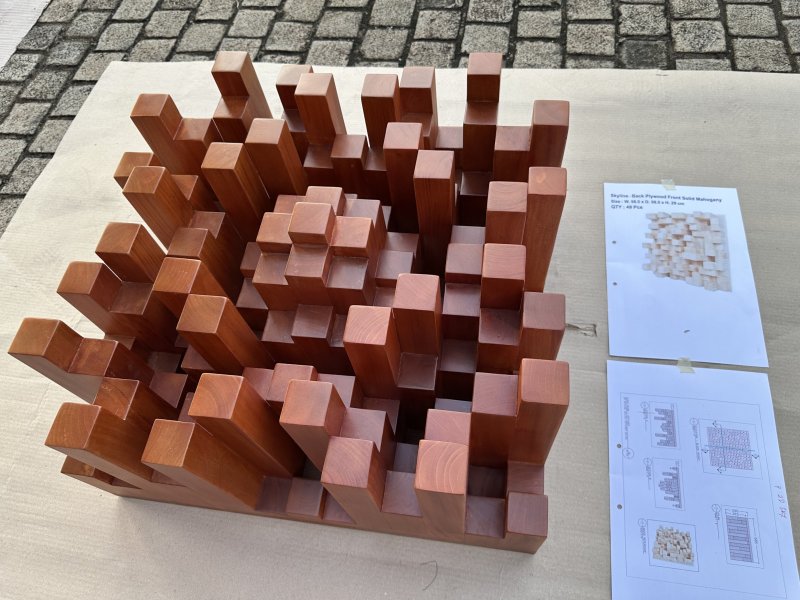
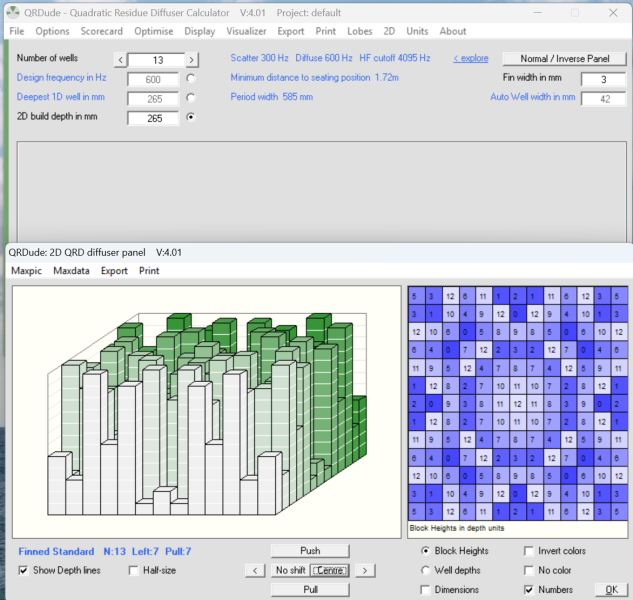

Weighing in at 39kgs each, these Skyline 2D QRDs are constructed from solid mahogany blocks, mounted on 25mm plywood.
49 pieces (or nearly 2,000kg!) of these will be mounted on the ceiling of my basement listening room at a height of 3.5m (11.5ft) , covering a width of 4.16m (13.6ft.) and a front/back length of 4.22m (13.8ft).
With its maximum depth/height of 265mm (10.4"), this 2D diffuser will start scattering sound from 300Hz, and from 600Hz up to 4.1kHz, diffuse musical energy into an amorphous but energetic overhead "cloud", creating the acoustic illusion of a much higher ceiling of perhaps ~5.0m (16ft).



Last edited:
Last edited:
Similar threads
- Replies
- 39
- Views
- 3K
- Replies
- 4
- Views
- 776
- Replies
- 0
- Views
- 744
- Replies
- 7
- Views
- 950
| Steve Williams Site Founder | Site Owner | Administrator | Ron Resnick Site Owner | Administrator | Julian (The Fixer) Website Build | Marketing Managersing |




